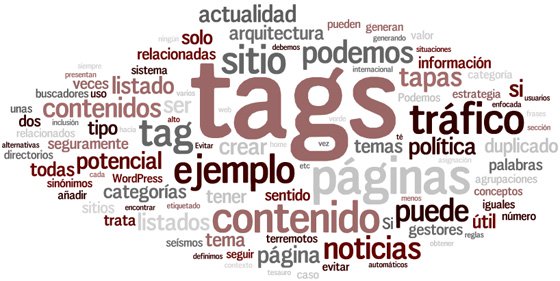Written by Fani Sánchez
What is a tag cloud?
When we talk about tag clouds, we refer to the visual representation of a group or family of tags, grouped in an abstract set that resembles the shape of a cloud and that have a common context or link.
It is a resource widely used in Online Marketing and SEO, a representation of the most prominent tags grouped and reflecting as a whole the thematic or topical content of the page or website.
In its visual aspect, the user will see that group of keywords labeled in different locations, shapes, sizes or colors, within the cloud. Normally the larger and more intense colors reflect the most important topics (in terms of relevance, volume of content or current affairs), while the less significant ones are smaller and have more degraded colors.
Objective of the tag cloud
The main objective of the tag cloud will be to facilitate the user’s search for information, by recurrently indicating the most relevant words and areas, current or abundant in relevant content, represented by those tags.
Secondly, to help the user in the navigability of the website, so that when clicking on any of these represented tags, we will take him to the content grouped under that tag, facilitating his access to those that are attractive and interesting to him.
Third, we have SEO benefits, the spiders will access directly to certain contents that are important to us, avoiding having to go down several levels in the web architecture to reach them, so that it is easier for them to find them easier when it comes to getting relevant content indexed for us. It is also a popularity boost with the links located in that tag cloud, through which that popularity juice is transferred and distributed among the pages to which the links contained in those relevant tags direct.
Among the SEO advantages of the tag cloud, it is worth mentioning that they will help us to highlight current topics, therefore of potential traffic, which will improve the traffic to those posts or pages related to those current topics.
Tag clouds help us at the SEO level with the optimization of indexability and architecture, which will allow us to improve navigation and traffic to our website.
It should also be noted that sometimes they are used without taking into account these objectives, as an attractive decorative motif to complete or accompany the content of the web page.
Inconveniences
The content management systems or CMS, allow the creation of tags and even recommend them to highlight the website’s keyword. For example, in WordPress, the user is offered this content tagging and can define a list of terms, separated by commas that will be associated with the tag.
Many users who build their website with these content managers, make an abusive use of tags, because for each tag a page is created and can result in the generation of junk content or thin content and duplicate content. When this happens and automatic tag clouds are created, the relevance of the tags can be greatly devalued, as well as giving prominence to junk or duplicate content, since the generation of these tag clouds in WordPress is usually based on the number of articles under the tag.
How tag clouds are made
There are various websites and web applications that help you create these tag clouds. Many of them are online tools that will allow you to create, modify and adapt them structurally and aesthetically, configure the design style, shapes, fonts, sizes or colors; and provide you with the code or the way to implement it on your website.
You can also make them by yourself with programs such as Photoshop, customizing it much more but the time investment will be much higher.
We recommend you to try some of them, such as Wordle, Wordaizer or Tagxedo among many others.
